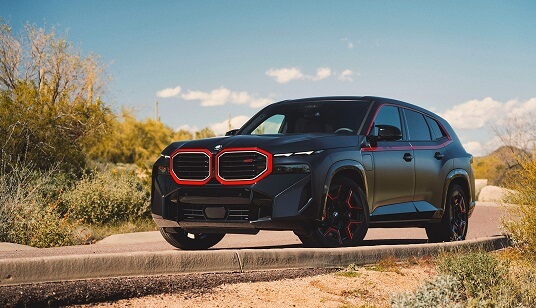

SUV, 5 Doors, 5 Seats
585 Hp @ 5600 rpm.
133.1 Hp/l
250 km/h, Electronically limited 155.34 mph
4395 cm3
268.2 cu. in.
8, V-engine
All wheel drive (4x4),
#N/D
#N/D
#N/D
| Brand | BMW |
|---|---|
| Model | XM (SUV) |
| Version | XM (G09) |
| Engine version | Label Red 4.4 V8 (748 Hp) PHEV xDrive Steptronic |
| Year production start | 2023 |
| Vehicle type | SUV |
| Horsepower RPM | 585 Hp @ 5600 rpm. |
| Acceleration 0 - 100 kmh sec | 3.8 sec |
| Doors | 5 |
| Top Speed | 250 km/h, Electronically limited 155.34 mph |
| Cam configuration | VALVETRONIC, Double-VANOS |
|---|---|
| Engine position and orientation | Front, Longitudinal |
| Cylinders | 8 |
| Position of cylinders | V-engine |
| Displacement (liters) |
4395 cm3268.2 cu. in. |
| Eng. horsepower RPM | 585 Hp @ 5600 rpm. |
| Horsepower per litre | 133.1 Hp/l |
| Torque Nm RPM lb-ft RPM |
750 Nm @ 1800-5400 rpm.553.17 lb.-ft. @ 1800-5400 rpm. |
| Bore (mm in) |
88.3 mm3.48 in. |
| Stroke (mm in) |
89.5 mm3.52 in. |
| Compression ratio | 10.5 |
| Fuel type | petrol / electricity |
| Valvetrain | 4 |
| Engine aspiration | Twin-power turbo, Intercooler |
| Emission certification | Euro 6d |
| Powertrain architecture | PHEV (Plug-in Hybrid Electric Vehicle) |
| Electric motor power | 197 Hp |
| Electric motor torque | 280 Nm 206.52 lb.-ft. |
| Total available power | 748 Hp |
| Totale available torque | 1000 Nm 737.56 lb.-ft. |
| Drive configuration | All wheel drive (4x4) |
|---|
| Front brakes | Ventilated discs |
|---|---|
| Rear brakes | Ventilated discs |
| Anti-lock brake system | ABS (Anti-lock braking system) |
| Steering type | Steering rack and pinion |
|---|
| Front suspension | Double wishbone |
|---|---|
| Rear suspension | Independent multi-link suspension |
| Wheels size | Front wheel tires: 275/45 R21 |
|---|---|
| Wheels rims | Front wheel rims: 21 |
| Passengers seats | 5 |
|---|
| Combined fuel consumption (WLTP) | 1.6-1.7 l/100 km 147.01 - 138.36 US mpg |
|---|
8 CYLINDER V-Engine
It's an engine with eight cylinder piston where the cylinders share a common crankshaft and are arranged in a V configuration.
What is the 8 cylinder V-engine displacement: it is in a range between 2926 cc and 8135 cc in recent model line up powertrain.
How much is the power of the 8 cylinder V-engine: the power of the 8 cylinder V-engine is in a range from 125 bhp to 1160 bhp.
Which cars use 8 cylinder V-engine: in recent years several manufactures have been used the V8 engine for 3 main applications: premium, sport cars and lightweight trucks. 8 V engine is the American preferred engine for iconic giant pick-up.
What is the eight cylinder V angle: the majority of V8 engines use a V-angle of 90 degrees. This angle results in good engine balance and low vibrations. The downside is a larger powertrain body that makes the use of this configuration suitable only for longitudinal position and rear drive wheels traction.
V8 engines with a 60 degree V-angle were used in the 1996-1999 by Ford and in 2005-2011 by Volvo. The Ford engine used a 60 degree V-angle because it was based on a V6 engine with a 60 degree V-angle. Both the Ford and Volvo engines were used in transverse engine chassis, which were designed for a front-wheel-drive layout. To reduce the vibrations caused by the unbalanced 60 degree V-angle, Volvo's used a balance shaft and offset split crankpins.
The Rolls-Royce Meteorite tank engine also used a 60 degree V-angle, since it was derived from the 60 degree V12 Rolls-Royce Meteor which in turn was based on the famous Rolls-Royce Merlin V12 engine.
Most V8 engines fitted to road cars use a cross-plane crankshaft, since this configuration produces less vibration due to the perfect primary balance and secondary balance.
The rumbling exhaust sound produced by a typical cross-plane V8 engine is partly due to the uneven firing order within each of the two banks of four cylinders and with separate exhaust systems for each bank of cylinders, this uneven pulsing creates the legendary rumbling sound that is typically of V8 engines.
edited by arrabbiata